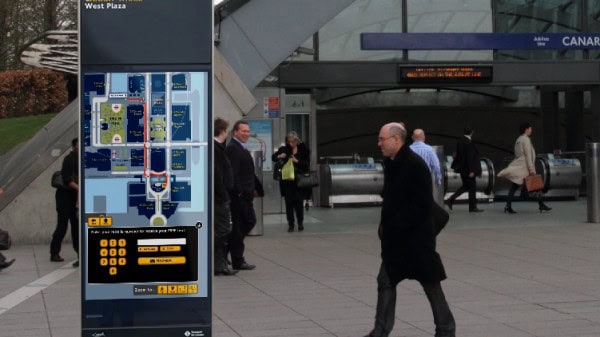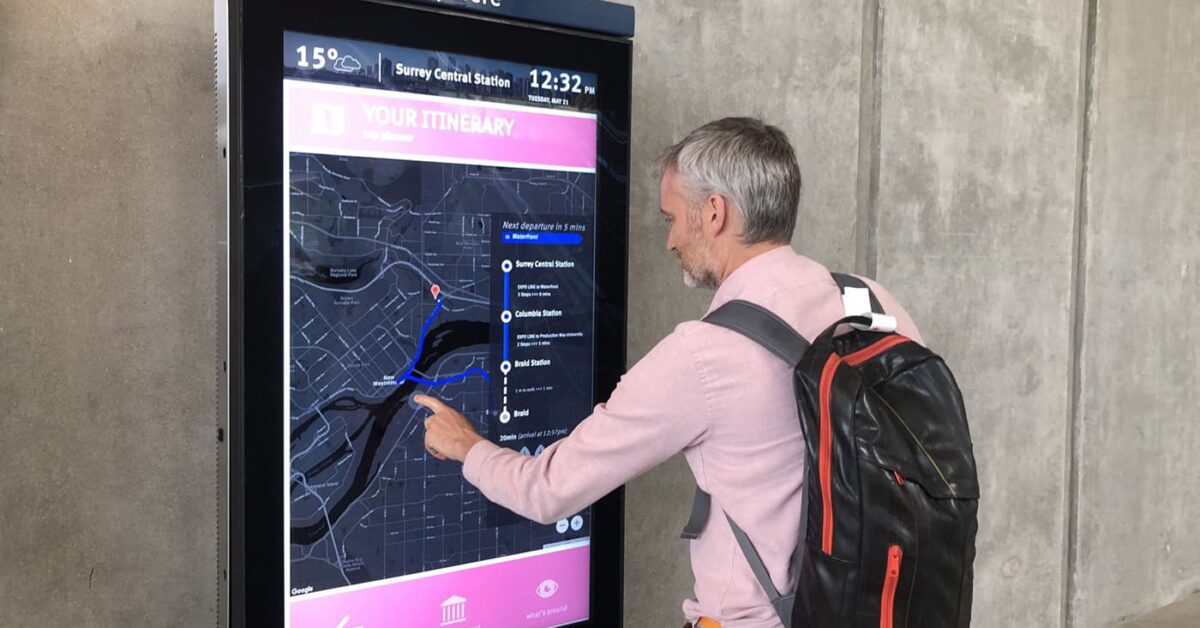Let’s face it: everyone has all the information they need in their pocket these days. Get instant access to navigation, reviews and personalized travel guides on your phone, Wayfinding Pavilion Obsolete before they have a chance to take off. For destination marketing organizations (DMOs), investing in wayfinding kiosks may seem like a useful addition to tourism infrastructure, but in reality, they often pose more challenges than benefits. In this article, we’ll break down five reasons why Wayfinding Pavilion May not be the best choice for DMOs, and they can sometimes become more of a burden than a solution.

Bulky information kiosks block much of the sidewalk
1. Everyone uses mobile devices to navigate
In today’s world, tourists and travelers rely heavily on smartphones for all their navigation needs. With apps like Google Maps, Apple Maps, and travel-specific tools at the tap of a finger, Wayfinding Pavilion has been significantly reduced. Most tourists prefer to easily get directions, restaurant recommendations and hotel reservations directly on their mobile phones rather than stopping at a physical kiosk. This trend makes kiosks less effective at engaging visitors, who have become accustomed to getting immediate and personalized information on their devices.
For DMO, this means resources for installation and maintenance Wayfinding Pavilion Can be better used to develop a mobile-friendly website, app or social media engagement strategy that delivers real-time information based on the needs of your visitors. These digital tools allow dynamic updates and provide greater flexibility to reach larger audiences.

2. High initial cost and long-term maintenance
Financial burden of installation and maintenance Wayfinding Pavilion is one of the biggest challenges facing DMOs. While the initial purchase and setup can be expensive, the ongoing maintenance costs can be just as high. Outdoor kiosks are susceptible to weather damage, vandalism and regular wear and tear and require ongoing repairs and upgrades to keep them operating at their best. On top of that, software updates and content management are additional ongoing costs that DMOs must consider.
Rather than investing in kiosks that require constant attention, these resources can be redirected to digital tools that require less maintenance and provide broader impact. Digital solutions can be updated instantly without the need for physical repairs or upgrades. In an era when budget efficiency is crucial, Wayfinding Pavilion This is often an outdated and costly solution for DMOs.

3. RFP process and long production times
Purchase and install Wayfinding Pavilion It often requires a long and complicated process. Most DMOs must publish Request for Proposal (RFP) Find the right supplier to build and install the kiosk. The process can take several months and includes various stages of approval, review and negotiation. Once a supplier is selected, the production timeline may extend by a year, especially if the kiosk needs to be customized for a specific location or purpose.
To make matters worse, the production of these kiosks is often outsourced to international manufacturers. This means that any delays caused by international shipping conflicts such as port issues or geopolitical tensions could further delay the installation date. Additionally, DMOs may find themselves in hot water if there is an issue with the hardware—returning faulty equipment to the manufacturer can be legally complex, especially if the parts were shipped from countries such as China. Finally, long production times and potential legal issues can become a significant drawback for DMOs seeking timely and effective solutions.

4. Information is outdated and slow to update
One of the most frequently asked questions Wayfinding Pavilion is that they are static systems. Once installed, their information quickly becomes outdated, especially in rapidly evolving fields tourist destination Where restaurants, attractions or activities may change frequently. Updating content on kiosks often requires manual software updates, which are not instant and can result in visitors receiving incorrect or out-of-date information.
In contrast, digital platforms such as apps or websites can be updated in real time, ensuring visitors always have access to the latest information. With mobile tools, DMOs can push updates instantly to keep visitors informed of any changes to local events, attractions or traffic. Wayfinding PavilionIn contrast, adaptation is slow, leading to frustration among visitors who may lose trust in the accuracy of the information provided.

5. Lack of personalized visitor experience
Modern travelers expect personalized experiences that meet their unique preferences and interests. Sorry, Wayfinding Pavilion Their ability to provide this level of customization is inherently limited. They often provide one-size-fits-all information without taking into account a user’s past behavior, preferences or travel history.
Digital platforms, on the other hand, allow for personalized recommendations. Apps and websites can analyze users’ search history, location and preferences to provide tailored recommendations to make the experience more relevant and engaging for travelers. this Personalized experience is becoming the new standard in the tourism industry, Wayfinding Pavilion There’s simply no way to compete with the flexibility and customization that mobile technology offers.

Businesswoman using digital tablet on train
6. Environmental and Sustainability Issues
As sustainability becomes an increasingly important concern for travelers and DMOs alike, Wayfinding Pavilion Can be seen as an outdated solution that is inconsistent with environmental goals. The production, transportation and installation of kiosks require significant resources, and the ongoing need for power and potential repairs increases their environmental footprint. Additionally, some kiosks still rely on paper maps or printed guides, creating unnecessary waste.
For DMOs focused on promoting eco-friendly travel options, Wayfinding Pavilion May conflict with sustainability initiatives. In contrast, digital solutions have minimal environmental impact and can often be updated and maintained remotely, reducing the need for physical materials and energy consumption. By choosing more sustainable technologies, DMOs can meet the growing demand for eco-friendly travel experiences.
Conclusion: Why wayfinding kiosks are a bad investment for DMOs
In an era where mobile technology dominates the way travelers navigate, Wayfinding Pavilion It will become obsolete quickly. They have limited coverage, are expensive to maintain, and cannot keep up with the rapid changes in the travel industry. For DMOs looking to provide visitors with a seamless and engaging experience, investing in digital platforms and mobile apps is a more effective strategy.
With personalized recommendations, real-time updates and broader reach, digital tools provide the flexibility and efficiency that modern travelers expect. In contrast, Wayfinding Pavilion Slow, static and outdated – this investment is best left in the past. By focusing on more dynamic solutions, DMOs can ensure they meet the needs of today’s tech-savvy travelers while optimizing budgets for long-term success.







